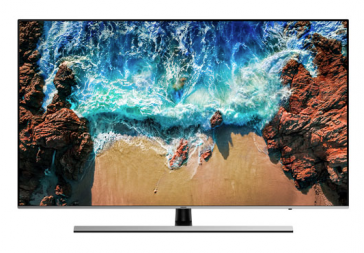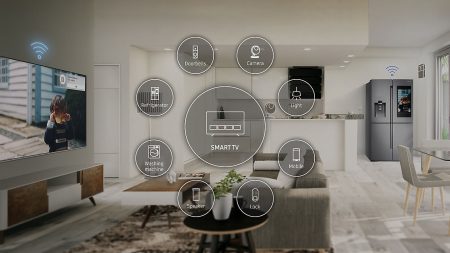
Depending on your current age, the idea of talking to your television and telling it what to do, and even having it answer you, is something straight out of a science fiction movie—or was a technology that seemed like the next logical evolution in your home electronics. Well, call me old because when I was growing up, smart technology existed in the realm of Start Trek or Star Wars and never seemed as if it could be a part of my home entertainment system. Science fiction continues to become the new reality and having a smart TV, potentially as a part of a larger smart home, is just one way for us to experience groundbreaking technology. There are, however, several ways to get the smart TV experience.
What is a “Smart TV”?
At its core, a smart TV refers to a television set that connects to the internet and provides access to online content. This is generally much more interactive for the user and also provides more choices around content and providers. If you still have a traditional satellite or cable account you will have that programming but also access to apps like Netflix, Crave, Amazon Prime Video, YouTube or other similar streaming services. You may also have a built-in browser that lets you surf the internet on your TV or even to access your own content on home computers, laptops, or networked storage servers. This can include music or movies that you have digitized. It may also provide you remote access to your content. So, how can you get a Smart TV experience in your home?
How to use a Smart TV
 Let us begin with the most obvious answer. Smart TVs generally connect to your Wi-Fi or directly to your network through a wired ethernet connection plugged into the TV and have an on-board Operating System (Firefox OS, Android TV with built-in Chromecast, Roku TV, or WebOS for example) that streams content for you. Most Smart TVs have pre-loaded apps as well that generally include Netflix, YouTube, and Amazon Prime Video among others.
Let us begin with the most obvious answer. Smart TVs generally connect to your Wi-Fi or directly to your network through a wired ethernet connection plugged into the TV and have an on-board Operating System (Firefox OS, Android TV with built-in Chromecast, Roku TV, or WebOS for example) that streams content for you. Most Smart TVs have pre-loaded apps as well that generally include Netflix, YouTube, and Amazon Prime Video among others.
The Samsung 65″ Tizen Smart TV is a 4K UHD LED model that features a built-in voice assistant. This lets you tell the TV what channel to turn to, or what type of programming you are looking for or that you now want to see what Netflix is offering. It has pre-loaded apps to streaming services like Netflix, YouTube, and Vimeo (you will require accounts to those if you do not already have one).
 The Samsung Tizen also integrates into your larger smart home as it can detect and connect to multiple smart devices. This includes smart devices like door locks, thermostats, security systems, appliances and mobile devices. Smart connectivity of this level potentially allows you to ditch the multiple remotes and control it all from the TV’s remote, or for even extra cool sci-fi cred, with your voice. There is even a SmartThings app for mobile devices that brings all of your devices together under one control umbrella.
The Samsung Tizen also integrates into your larger smart home as it can detect and connect to multiple smart devices. This includes smart devices like door locks, thermostats, security systems, appliances and mobile devices. Smart connectivity of this level potentially allows you to ditch the multiple remotes and control it all from the TV’s remote, or for even extra cool sci-fi cred, with your voice. There is even a SmartThings app for mobile devices that brings all of your devices together under one control umbrella.
With this as the added level of smart capabilities, we haven’t even discussed the traditional features on these televisions like screen size, resolution, or general aesthetic design. As the television is the hub of any home cinema endeavour, these will most certainly be important considerations if you are going out to purchase a new television. But what if you already have a perfectly functional TV and just want some of the smart TV features?
What can streaming devices do for me?
 While I do have a 4K smart TV in my media room, we also have a decent HDTV that is about 5 years old at this point but does not have smart TV connectivity. With the simple addition of a streaming device, I have access to the online content available on my newer and smarter TV. In my instance I have an Apple TV but you have many options for streaming devices at this juncture in time. Chromecast, NVIDIA Shield, or Roku are just a few examples and I wrote a blog a couple of months ago that went into significant detail on those particular streaming devices and their capabilities.
While I do have a 4K smart TV in my media room, we also have a decent HDTV that is about 5 years old at this point but does not have smart TV connectivity. With the simple addition of a streaming device, I have access to the online content available on my newer and smarter TV. In my instance I have an Apple TV but you have many options for streaming devices at this juncture in time. Chromecast, NVIDIA Shield, or Roku are just a few examples and I wrote a blog a couple of months ago that went into significant detail on those particular streaming devices and their capabilities.
These streaming devices generally connect to your home Wi-Fi, although some can accept a direct ethernet connect, and give you access to the same online content as the smart TVs do. Some devices like the new Apple TV or the Roku Ultra provide voice control ability which makes your seemingly eternal quest for new and exciting content somewhat more manageable. Even if you already own a smart TV you may benefit from the addition of a streaming player to your home entertainment system. If, for example, you are an avid gamer then the NVIDIA Shield streaming player would be the perfect accomplice to your smart TV and grant you even more control and flexibility in your home entertainment universe.
Blu-Ray Player with streaming sapabilities
 As amazing as these streamers and smart TVs are, a true cinephile will likely want to look at a new 4K Blu-Ray player. While a streaming player can online play online content by streaming it to your television set, the newest batch of Blu-Ray Players can do that as well as playing traditional DVD and Blu-Ray discs as well as new 4K content via Blu-Ray discs. One advantage to this is quality. You are not beholden to a fast internet connection when you play from a disc. As such, your movie viewing quality is consistent and in the best possible resolution with no dropping of frames or buffering.
As amazing as these streamers and smart TVs are, a true cinephile will likely want to look at a new 4K Blu-Ray player. While a streaming player can online play online content by streaming it to your television set, the newest batch of Blu-Ray Players can do that as well as playing traditional DVD and Blu-Ray discs as well as new 4K content via Blu-Ray discs. One advantage to this is quality. You are not beholden to a fast internet connection when you play from a disc. As such, your movie viewing quality is consistent and in the best possible resolution with no dropping of frames or buffering.
While Netflix and a few other streaming services are introducing more 4K and UHD content (albeit costing you more in your subscriptions to access this premium content), new 4K Blu-Ray players like the Sony 4K UHD WiFi Blu-Ray player offers you the best of both worlds. You get to watch 4K movie discs in cinema quality resolution and with cinema quality audio, provided you have the receiver and speakers. These players also connect to online content like the regular media streaming players and include apps like Netflix et al. You really can have it all, at least in the modern home theatre.
Bonus Smart Fun
 While modern connected voice assistants like Alexa, Google Assistant, or even Apple’s Siri can’t exactly provide you with access to online content in the same way as a smart TV or a streaming player, they can certainly integrate into your system to make the whole smart experience even better. I currently have both Amazon’s Alexa (in the form of a couple of Echo Dots) and a Google Assistant (via a Polk Assist Smart Speaker) integrated into my larger home entertainment system. Both are synced to my smart TV and give me voice control to power, volume, or content.
While modern connected voice assistants like Alexa, Google Assistant, or even Apple’s Siri can’t exactly provide you with access to online content in the same way as a smart TV or a streaming player, they can certainly integrate into your system to make the whole smart experience even better. I currently have both Amazon’s Alexa (in the form of a couple of Echo Dots) and a Google Assistant (via a Polk Assist Smart Speaker) integrated into my larger home entertainment system. Both are synced to my smart TV and give me voice control to power, volume, or content.
If I ask her, Alexa will remind me when the hockey game is staring or the Google Assistant will tell me what a movie scored on the IMDB ratings. Go a step further by including some smart light bulbs then at the end of a busy day, make a bucket of popcorn, sit down on your comfy couch and tell your assistant to dim the lights, turn on the TV, switch to Netflix, start a particular movie and then lose yourself for the next couple of hours. You work hard and you deserve it. If that isn’t the real definition of smart, I don’t know what is.




Your article is very beautiful and filled with information. This use of this smart TV is going to be a lot in the coming time. So thank you very much for sharing such good information.
Comments are closed.